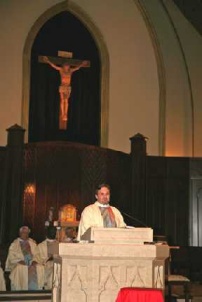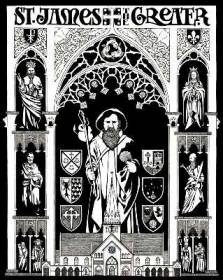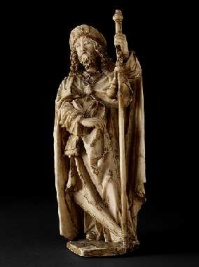The Rites of Dedication
Church of Saint James the Greater
Charles Town, West Virginia (cont.)
Liturgy of the Eucharist
Music during the Offertory Procession
Christ Is Made the Sure Foundation (text: from Angularis fundamentum; tune: Westminster Abbey) – Congregation, Trumpet, Organ
Prayer over the Gifts
Eucharistic Prayer
- Preface Dialog
- Preface
- Sanctus
from Heritage Mass (Owen Alstott)
- Prayer
- Memorial Acclamation: Christ has died
from Heritage Mass (Owen Alstott)
- Prayer
- Great Amen
from Heritage Mass (Owen Alstott)
Lord's Prayer sung to traditional chant melody
Embolism
Doxology sung
Rite of Peace
Agnus Dei
from Heritage Mass (Owen Alstott)
Invitation to Communion
Communion Motets
Agnus Dei (Orlando di Lasso) – Saint James Festival Choir
Tollite hostias (Camille Saint-Saëns) – Saint James Festival Choir, Brass, Organ
Communion Hymn
How Lovely Is Your Dwelling Place (Randall DeBruyn) – Organ, Flute, Choirs, Congregation
Meditation after Communion
Ave Maria (Moritz Brosig) – Saint James Festival Choir
Prayer after Communion

Inauguration of the Blessed Sacrament Chapel
- Prayer
- Procession to the Tabernacle
Domine Deus Rex cælestis from Gloria in D (W.A. Mozart) – Youth Choirs
- Incensation of the Blessed Sacrament
Concluding Rites
Address by Pastor
Solemn Blessing
Dismissal
Closing Song
Ye Watchers and Ye Holy Ones (tune: Lasst uns erfreuen) – Congregation, Brass, Timpani, Organ
Postlude
Toccata from Symphony No.5 – Organ
Ministers of the Liturgy
Celebrant: The Rev. Michael J. Bransfield DD, Bishop of Wheeling-Charleston
Pastor: The Rev. Brian Owens
Hispanic Ministry: The Rev. Tadeusz Mich
Deacons: The Rev. Mr. David E. Galvin & The Rev. Mr. Carl C. Crump
Social Outreach Ministry: Sr. Theresa Camillo, SJI
Seminarian: José Manuel Escalante
Stewardship: Jackie Moler
Masters of Ceremonies: The Rev. Paul A. Hudock & The Rev. Dennis Schuelkens
Organist: Dr. Stephen Cooksey, Professor of Music, Shenandoah Conservatory
Choirs: Saint James Festival Choir, Saint James Schola Cantorum, Immaculate Heart Choir, Sacred Heart Choir
Adult Choir Director: Gary D. Penkala, Pastoral Associate for Liturgy and Music
Youth Choir Directors: Carol Hayes & Nancy Guiney
Cantor: Alice Hubscher
Brass Ensemble: National Chamber Brass (Bill Adcock, Chris Wilson, Danny Helseth, Chris Quade)
Timpani: Randy Gorman
Violin: Elizabeth Lademan
Cello: Kevin Uppercue
Flute: Jacqueline Mauceri
Dedication Coordinator: John Sherwood
Dedication Program Cover
Copyright © 2005 Daniel Mitsui

Daniel Mitsui, the artist for this cover, is a graduate of Dartmouth College and a freelance illustrator in Chicago.
He concentrates on sacred artwork in the Roman Catholic tradition, being particularly interested in medieval art, architecture and manuscript illumination.
The Parish of Saint James the Greater commissioned Mr. Mitsui to create for us the illustration you see to the right.
Faithful to Medieval tradition, it is filled with intricate tracery and artistic symbols that hold profound meaning.
Mr. Mitsui describes the illustration this way:
Due to the popular annual pilgrimages to the Cathedral and Shrine of Santiago (Saint James) in Compostela, Spain, Saint James the Greater has become the patron saint of pilgrims, and often appears in art with the traditional clothing and tools of a pilgrim – these include a broad hat to shield the sun, a water bottle, and a staff.
All of these have been incorporated into this drawing – and the staff is also a boat hook, to indicate the saint's former work as a fisherman – and later work as a fisher of men.
He holds a scallop shell, another of his traditional attributes.
Scallop shells were brought back by pilgrims from Compostela as souvenirs – the seaside city where the basilica is located is famous for this seafood.
Also depicted are Our Lord, as Christ the King holding an orb, the symbol of his sovereignty over the entire world, and imparting a blessing; Our Lady; Saint Peter, holding his keys; and Saint Paul, holding a book of his epistles and the sword of his martyrdom.
Saint Barbara, the patroness of architecture, Saint Jerome, Saint Augustine, and Saint Cecilia, patroness of music, are drawn at the bottom.
The architecture surrounding the saints is based on the bridal door of the Gothic Church of Saint Sewald in Nuremburg, an etching of which I saw in the architectural patternbook Medieval Ornament by Karl Alexander von Heideloff, who restored numerous German churches in the 19th century.
The use of a Gothic frame references the great architectural tradition continued by the designers of Saint James Church, which is drawn in miniature at the bottom, under the protection of its patron.
The decorations in the frame show numerous fish, including three arranged in a circle as an ancient symbol of the Holy Trinity.
There are also grape leaves, scallop shells, gargoyles, and coats of arms.
The six heraldic crests alongside Saint James have the following significance:
- At the top left are the parochial arms, with three scallop shells and a Saint James Cross.
- Across from it is a shield that I saw in an old photograph of pilgrims to Santiago de Compostela.
- Below them are the arms of Charles the Great, and a shield with the constellation Virgo and a compass pointing west.
These are a rebus (pictogram) for Charles Town, West Virginia.
- At the bottom left is a shield with a larger Saint James Cross.
This peculiarly shaped cross was used in the arms of the Order of Saint James, a chivalric order of the Spanish Reconquest.
- And the bottom right are the arms of the currently reigning pontiff, Pope Benedict XVI.
Saint James the Greater

Like his brother, Saint John the Evangelist, James occupied a prominent position among the Twelve.
Coming second or third to Peter in the official lists, he was also singled out, with Peter and John, to be a privileged witness of the raising of the daughter of Jairus, the Transfiguration, and the Agony in the Garden.
A fisherman of Bethsaida, of a family perhaps, of more than ordinary means — his father, Zebedee, could afford hired men (Mark 1:19-20), and his brother was personally known to the High Priest (John 18:15-16) — James shared with John the nickname Boanerges, "Sons of Thunder."
This title, bestowed by Christ (Mark 3:17), suggests that the brothers were impetuous and hot-tempered, and we may see this exemplified in different ways in the two incidents described in Luke 9:54 and Mark 10:35-41.
James was put to death by the sword at the command of Herod Agrippa (Acts 12:2), probably in the year 44.
Toward the end of the second century, Clement of Alexandria, relying on the information of "those before him," stated that the apostle's accuser was himself converted, and suffered at the same time as James.
Saint James the Greater, the apostle, is not to be confused with the author of the Epistle of James. Saint James and his brother John are the sons of Zebedee.
The official tradition at Compostela in Spain placed the discovery of the relics of the saint in the time of King Alfonso II (791-842) and of Bishop Theodemir of Iria.
These traditions were the basis for the pilgrimage route that began to be established in the 9th century, and the shrine dedicated to James at Santiago de Compostela, in Galicia in Spain, became the most famous pilgrimage site in the Christian world. Saint James' Way is a set of routes that cross Western Europe and arrive at Santiago through Northern Spain.
The routes are distinguished by the distinctive symbols of the Saint James Cross and the scallop shell.
Eventually James became the patron saint of Spain and later the patron saint of horsemen and equestrians.
The name "James" in English comes from Iacobus (Jacob) in Latin.
In eastern Spain, Jacobus became Jacome or Jaime; in western Spain it became Iago.
"Saint James" (Sanctus Jacobus) became Sant'Iago, which was abbreviated to Santiago.
This has sometimes been confused with San Diego, which is the Spanish name of Saint Didacus of Alcalá.
James' emblem was the scallop shell (or "cockle shell"), and pilgrims to his shrine often wore that symbol on their hats or clothes.
They would also pick up shells from the nearby beach to take home as a gift of their pilgrimage.
The French term for a scallop is coquille St. Jacques, which means "cockle (or mollusk) of Saint James."
|



